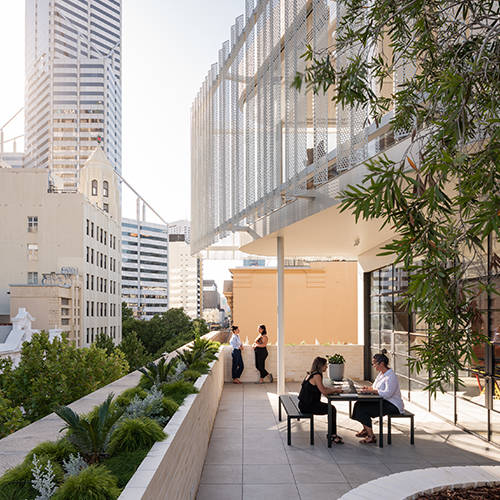The design of amenities might be considered less important by some, but commercial and retail clients take it as seriously as we do.
You might have read about the $1 million bathrooms at the Vue de Monde restaurant and the Lui Bar in Melbourne. Restaurateurs know that brilliant food and fantastic service is not the whole package in a first-class dining experience. Getting the bathroom design wrong can be a brand-destroying moment.
Similarly, in a shopping centre, if a mother opens the door to the parent’s room and it is not appealing and ‘fit for purpose’, it may affect her revisiting the centre again, and therefore impact the overall shopping centre’s revenue.
As designers, every project should be a challenge and this includes bathroom design, where there are many considerations to balance – safety and security for example – and was getting it right can really make a difference to the patrons’ experience of a centre.
Amenities, in particular, bathrooms, are one of the most heavily regulated and ‘code’ prescribed parts of any commercial project and that can be particularly challenging when working on existing premises. In new spaces, there is more flexibility to control the dimensions, but with established buildings, designers are faced by the constraints of existing services and the complications of the lack of space to ensure all amenities accommodate and comply with current accessibility standards.
So, based on the success of a series of recent amenity projects, I’m taking this opportunity to share some of the essentials of designing successful amenities.
Safety is at the forefront of one’s mind, and thus, instead of doors, we often use a zigzag entry allowing a transparent threshold without compromising essential privacy. As well as being much easier to negotiate with prams, shopping trolleys and packages, door-less entries are safer: it makes it easier for shoppers or centre staff to be aware if someone is in difficulty.
Universal access means a lot of subtlety in design – for example, ensuring colour selections of finishes and even the toilet seat provides adequate contrast to its context. Allocating enough circulation space for universal access (which can alter the design aesthetics to achieved ease of movability), and communication through specific signage are just some design considerations when designing for accessibility.
The humble parent room has also come a long way from its earlier iterations. Parents typically come to shopping centres with one or more children to manage, a difficult enough task when just strolling from shop to shop. When it’s time for a nappy change or a feed, the complications really escalate.
What we are trying to provide is a safe and uncomplicated haven for parents to attend to these tasks while still being able to oversee their other child or children.
Visual security plays an important role. If a mother sits down to feed one child, she has to be able to see her other children at all times. That is much easier if the kids are happily entertained within the parents’ room.
Some facilities just provide a box of plastic toys or a TV screen but, apart from looking unappealing, a better design is likely to be more effective.
In a recent project, for example, we designed a three-dimensional tree into the play space. The trunk was made out of smoothed timber, with 3D green ‘clouds’ fixed to the ceiling. It creates the calming feeling of sitting under a tree and gives an outdoor feeling, despite the confined space.
Parents can watch their children from the nursing cubicles around this play space, which has low height glass walls with green graphics decals. There is an element of screening for nursing parents, but the children are still visually controlled.
In the same project, we created an interactive wall, with good old traditional building blocks that went into holes made in the wall, fell down and came out the bottom. Sometimes the simplest ideas are the best.
It might not often be a topic of conversation, but well-designed amenities can be brand builders.






